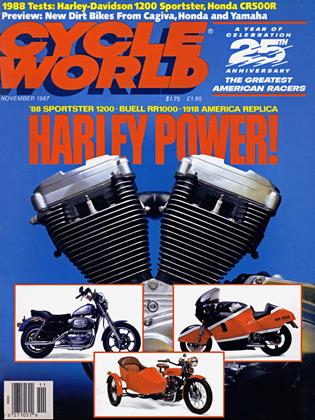MICHELIN BIB MOUSSE
EVALUATION
Foam sweet foam
LOOK HOW FAR WE'VE COME. IN REcent years, the threat of burned ignition points has been completely eliminated. New motorcycles don’t leak oil. And even valve adjustments may soon be filed away in the nasty memories book, somewhere between the chapter on polio and the one on smallpox. But, so far, there has been no vaccine for the most common motorcycle malady of all: the flat tire.
Until now, that is. Michelin Rubber Company of France has developed a product that threatens to make the flat tire a thing of the past for off-road bikes. It’s called the Bib Mousse, and basically, it’s an airless inner tube made of closed-cell foam, similar to that used in handlebar crossbar pads. The name comes from that roly-poly man you see in the Michelin ads (Mr. Bib, as he’s called in France), and the French word for “foam” (mousse, as in chocolate mousse dessert).
Because the Mousse is solid and does not deflate, installing one is just as difficult as you might expect; it’s like mounting a tire with an inflated inner tube already inside. The job requires several large C-clamps, a lot of elbow grease, and at least a half-hour of your time. Michelin has a special lubricant that you smear all over the Mousse to ease its passage, but Vaseline works just about as well.
Once fitted with a Mousse, a tire behaves just like a normal air-filled tire with about 12 psi of air pressure. The Mousse weighs about three pounds, as opposed to one or two pounds for a heavy-duty tube, but very few riders are able to detect the difference in unsprung weight.
They will notice a difference in tube life, however. We gave the Mousse a thorough torture test by using the same two in the front and rear tires throughout a season of off-road competition that included one grand prix, two enduros and five two-day qualifiers. And altogether, those two Mousses outlasted nine tires. Each tire change, though, revealed at least one new tear in each Mousse, usually made during the removal process. But those tears were repaired with Shoe-Goo, the stuff made for mending the soles of running shoes. Finally, one of the tears worked its way completely through the front Mousse, but only after a long, flatless racing career. The rear is still intact and on the job.
Actually, the only way a Mousse is likely to suffer a premature demise is with extended periods of high-speed riding. Baja racer Bruce Ogilvie found that out by riding his Mousseequipped Honda XR600 at over 80 mph for a long period of time on pavement. The result was a melted Mousse and a DNF. But the product wasn’t designed for that; rather, it is intended for racing on dirt at lower speeds and for off-road play-riding.
With each use. a Mousse gets a wee bit softer, making the tire feel like it has less and less inflation pressure. This affects the front more than the rear, so by the time the season is over, it’s time for a new Mousse, even if the foam has no tears. But new Mousses aren’t cheap. They’re sold only with an accompanying Michelin tire, with package prices ranging from between $149.95 for a 90/90-21 front Mousse and tire, to $169.95 for a 140/90-18 rear (from the sole U.S. distributor, International Cycle Racing Tires, 1865 Redondo Ave., Long Beach, CA 90804; [213] 597-0339).
That’s a hefty tariff; but when you consider that flats are the single most common cause of spoiled rides, the Bib Mousse could be the cheapest and most effective insurance policy you can buy.
 View Full Issue
View Full Issue
More From This Issue
-
 Departments
DepartmentsEditorial
November 1987 By Paul Dean -
 Letters
LettersLetters
November 1987 -
 Roundup
RoundupThe Danforth Problem: Time For Action
November 1987 By Camron E. Bussard -
 Preview
Preview1988 Honda Cr125 And Cr250
November 1987 -
 Preview
Preview1988 Yamaha Yz125, Yz250 And Yz490
November 1987 -
 Features
FeaturesThe Bike That Buell Built
November 1987 By David Edwards




